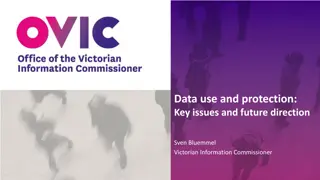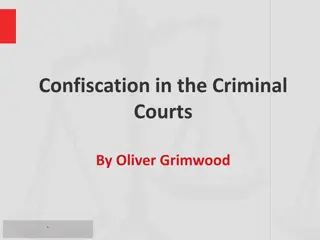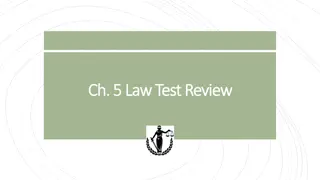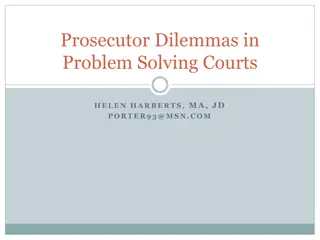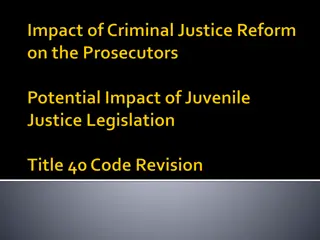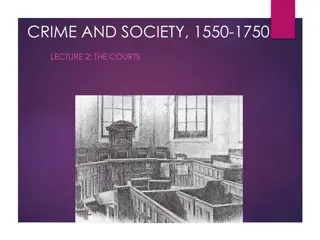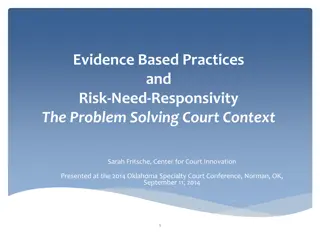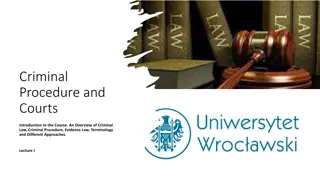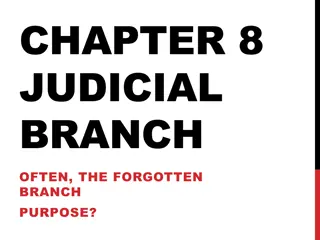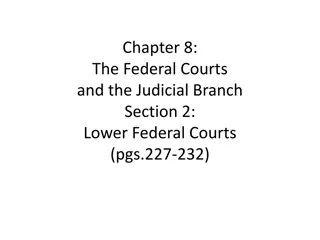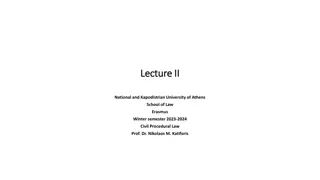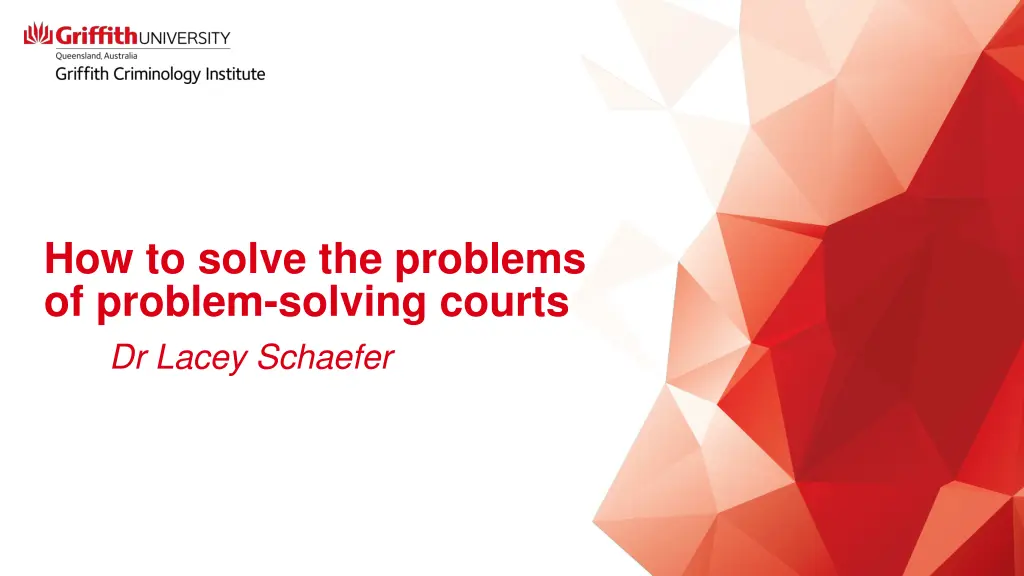
Solving Challenges in Problem-Solving Courts with Dr. Lacey Schaefer
Explore the intricacies of problem-solving courts with Dr. Lacey Schaefer. From understanding the prospects and pitfalls to finding solutions, delve into the world of collaborative case management, treatment provisions, and judicial monitoring in an effort to address the root causes of crime. Discover the unique features of problem-solving courts in Australia and the comparison with other countries. Gain insights on reducing the punishment component of criminal justice processes through non-adversarial and rehabilitation-oriented approaches.
Download Presentation

Please find below an Image/Link to download the presentation.
The content on the website is provided AS IS for your information and personal use only. It may not be sold, licensed, or shared on other websites without obtaining consent from the author. If you encounter any issues during the download, it is possible that the publisher has removed the file from their server.
You are allowed to download the files provided on this website for personal or commercial use, subject to the condition that they are used lawfully. All files are the property of their respective owners.
The content on the website is provided AS IS for your information and personal use only. It may not be sold, licensed, or shared on other websites without obtaining consent from the author.
E N D
Presentation Transcript
How to solve the problems of problem-solving courts Dr Lacey Schaefer
ACKNOWLEDGEMENT OF COUNTRY Griffith University acknowledges the people who are the traditional custodians of the land. We pay respect to the Elders, past and present, and extend that respect to all Aboriginal and Torres Strait Islander peoples. CRICOS: 00233E | TEQSA: PRV12076
Acknowledgements Ms Mary (Beriman) Andrews and Mrs Caitlyn Egan Dr Lacey Schaefer l.schaefer@griffith.edu.au
Presentation Overview Introduction of problem-solving courts Prospects of problem-solving courts Pitfalls of problem-solving courts Solving the problems of problem-solving courts Dr Lacey Schaefer l.schaefer@griffith.edu.au
Disclaimers Problem-solving courts versus solution-focused courts Focused on the Australian experience Drawing on the collective evidence-base Dr Lacey Schaefer l.schaefer@griffith.edu.au
Introduction of Problem-Solving Courts
What Are Problem-Solving Courts? Problem-solving courts (PSCs; speciality courts) vary greatly in their targets, methods, and modes Focus on addressing the underlying causes of crime Collaborative case management Treatment provisions and service referrals Judicial monitoring Premised on principles of therapeutic jurisprudence Reduces the punishment component of CJS processes Non-adversarial and rehabilitation-oriented Dr Lacey Schaefer l.schaefer@griffith.edu.au
Introduction of PSCs to Australia Somewhat comparable to the US, UK Uniquely Australian features Nolan (2012): American PSCs feature boldness, enthusiasm, and pragmatism, others have historically embraced moderation, deliberation, and restraint Freiberg (2001): Where the United States treads boldly, rapidly, and sometimes foolishly, Australia tiptoes carefully, slowly, and most times reluctantly For instance: pilot tests and evaluations Dr Lacey Schaefer l.schaefer@griffith.edu.au
Introduction of PSCs to Australia Initial cautious tone since their introduction in late 1990s The AIC priorities (early 2000s): Drugs and alcohol Domestic and family violence Forensic and mental health Indigenous justice Hallmark feature of the Australian experience: development of native solutions to local problems Subject to fluctuations in government and corresponding CJS ideology Dr Lacey Schaefer l.schaefer@griffith.edu.au
So What Is A Problem-Solving Court? Thus quite difficult to take inventory or draw defining lines To illustrate: With variations between and within states and territories, and across court types and time: Vary by eligibility criteria: Guilty plea versus suspended plea Recorded offence type (e.g. drug possession) versus assessed need (e.g. threshold degree of addiction) Chronic offenders versus first-time offenders Genuinely motivated versus threat of incarceration Vary by process: entry points, check points, exit points Shaped by local agents and agencies Dr Lacey Schaefer l.schaefer@griffith.edu.au
So What Is A Problem-Solving Court? Australian PSCs are still negotiating their identity The benefits of locally flexible, customisable solutions can lead to inconsistency Scope shift: Problem-solving court or: Therapeutic jurisprudence (e.g. restorative justice)? Specialist adjudicators (e.g. Indigenous justice)? Diversionary operators (e.g. managerialism)? As a result, blurred boundaries and muddied meaning Dr Lacey Schaefer l.schaefer@griffith.edu.au
Prospects of Problem-Solving Courts
Prospects of PSCs Since subject to scrutiny, we know much about them Many evaluations are government-commissioned Many forms of evaluation means knowledge about many features of PSCs: Outcomes Process Cost-benefit Black box Several successes noted Dr Lacey Schaefer l.schaefer@griffith.edu.au
Problems Solved by Australian PSCs Participant satisfaction Generally all court users (e.g. perpetrators, victims, staff) as well as the public Collaboration Case coordination between the court and community resources Effectiveness Promising impact on recidivism for particular cohorts Dr Lacey Schaefer l.schaefer@griffith.edu.au
Pitfalls of Problem-Solving Courts
Pitfalls of PSCs Many promising features of the Australian PSC landscape, but not immune to challenges Dr Lacey Schaefer l.schaefer@griffith.edu.au
Problems of Australian PSCs The problem of scope: What is a problem? Defines who or what requires intervention Defined too narrowly? Lose your market or no infrastructure Defined too broadly? Net widening in an oversupply of cases that need help Preference for Australian paternalism (e.g. government intervention, infantilises defendants)? PSCs fail to assess eligibility criteria Risk principle PSCs fail to assess treatment needs Criminogenic need principle Dr Lacey Schaefer l.schaefer@griffith.edu.au
Problems of Australian PSCs The problem of access Australia is remarkably urbanised (89% metro, 67% capital) Resources are concentrated Clients in regional, rural, remote areas are disadvantaged Even metropolitan areas may fail to supply the demand May even restrict availability to non-CJS service users Dr Lacey Schaefer l.schaefer@griffith.edu.au
Problems of Australian PSCs The problem of substance Not every activity under the banner of treatment is of quality Many treatments violate the principles of effective correctional intervention Violation of the risk principle Violation of the need principle Violation of the responsivity principle Some positive effects due to intermediate outcomes, pre- existing risk levels, and self-selection biases Dr Lacey Schaefer l.schaefer@griffith.edu.au
Problems of Australian PSCs The problem of constitutionality The lack of blanket legal rights and procedural safeguards may mean that offenders are harmed more than traditional processes Three main criticisms: The judge is no longer an impartial adjudicator The Australian Guide to Judicial Conduct (2017) states that judges must avoid stepping into the arena or appearing to take sides The courts are now medicating rather than adjudicating Coerced treatment: Do defendants have rights when the alternative is imprisonment? The imbalance between treatment and due process What happens when offenders fail? Dr Lacey Schaefer l.schaefer@griffith.edu.au
Solving the Problems of Problem-Solving Courts
Balancing the Problems and Solutions Australian problem-solving courts have solved many enduring crime and justice problems In achieving these wins, new problems have emerged Not insurmountable, but require attention If courts are to be retained and propagated To maximise effectiveness How to solve these problems? Five proposed solutions Dr Lacey Schaefer l.schaefer@griffith.edu.au
Proposed Solutions Improving access Technology-facilitated justice Reconsidering breaches for lack of programs, services Dr Lacey Schaefer l.schaefer@griffith.edu.au
Proposed Solutions Improving assessments For PSCs to be effective, they must: Target individuals with particular problems; Understand the nature of that individual s problem; and Implement solutions that target that nature. These courts must routinely and reliably use validated, actuarial instruments Dr Lacey Schaefer l.schaefer@griffith.edu.au
Proposed Solutions Improving services If PSCs pull the legal lever of treatment, they must be held to account for the quality of that treatment Treatment should be evidence-based Treatment should be holistic (requiring true interagency cooperation) Treatment cannot prioritise social service provisions related to concrete needs to trump correctional intervention Should not assume that improved effectiveness of PSCs versus BAU means that treatment is working Dr Lacey Schaefer l.schaefer@griffith.edu.au
Proposed Solutions Improving processes PSCs require supporting legislation that (re)defines their scope, aims, and procedures Flexibility is required, but cannot be at the cost of standardised practices Otherwise: Risk replacing cautious tone with a capricious one As such: Therapeutic courts can be harmful (e.g. around the voluntariness of participation, punishments for failures ) Dr Lacey Schaefer l.schaefer@griffith.edu.au
Proposed Solutions Improving research PSCs are too often declared successful without persuasive proof and are then expanded Justice innovations should be guided by research, and better evidence is required Outcome evaluations are lacking Rigorous (quasi-)experiments are required Grey literature and the file drawer problem Dr Lacey Schaefer l.schaefer@griffith.edu.au
Summary Australian PSCs are at a fork in the road While the courts have selectively borrowed from their American counterparts, this gap is closing They cannot be everything to everyone, so a return to their guiding principles is needed Therapeutic jurisprudence Addressing the underlying cause of offending If we want PSCs to be effective: The solutions must be appropriately tailored to the problem And thus, the problem must be clearly defined Dr Lacey Schaefer l.schaefer@griffith.edu.au
References Freiberg, A. (2001b). Three strikes and you re out It s not cricket: Colonization and resistance in Australian sentencing. In M. Tonry & R. S. Frase (Eds.), Sentencing and sanctions in Western countries (pp. 29 61). New York: Oxford University Press. Nolan, J. L., Jr. (2012). Problem-solving courts: An international comparison. In J. Petersilia & K. R. Reitz (Eds.), The Oxford handbook of sentencing and corrections (pp. 150 172). New York: Oxford University Press. Schaefer, L., & Beriman, M. (2019). Problem-solving courts in Australia: A review of problems and solutions. Victims & Offenders, 14(3), 344-359. Schaefer, L., & Egan, C. (2022). Problem-solving courts in Australia. In M. Camilleri, A. Harkness, & R. Hale (Eds.), Australian courts: Controversies, challenges, and change (pp. 197-220). London: Palgrave. Dr Lacey Schaefer l.schaefer@griffith.edu.au
Questions? Dr Lacey Schaefer l.schaefer@griffith.edu.au






